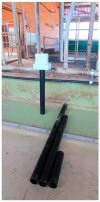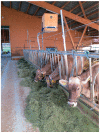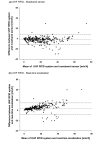Setup, Test and Validation of a UHF RFID System for Monitoring Feeding Behaviour of Dairy Cows
- PMID: 33316897
- PMCID: PMC7764485
- DOI: 10.3390/s20247035
Setup, Test and Validation of a UHF RFID System for Monitoring Feeding Behaviour of Dairy Cows
Abstract
Feeding behaviour can be used as an important indicator to support animal management. However, using feeding behaviour as a tool for dairy cow management an automatic sensor system is needed. Hence, the objective of this study was to setup, test and validate a ultra-high frequency (UHF) radio-frequency identification (RFID) system for measuring time dairy cows spent at the feed fence using two types of passive UHF ear tags. In a first experiment, the reading area of the system was evaluated in two antenna positions. Subsequently, the UHF RFID system was validated with video observations and compared to the measurements of chewing time of a noseband pressure sensor and of the time spent at the feed fence registered by a sensor system with real-time localisation. Differences in the reading area were detected between the two antenna positions and types of ear tag. The antenna position leading to less false positive registrations was chosen for the experiment with cows. The validation with video data showed a high average sensitivity (93.7 ± 5.6%, mean ± standard deviation), specificity (97.8 ± 1.1%), precision (93.8 ± 2.3%) and accuracy (96.9 ± 0.9%) of the UHF RFID system for measuring the time spent at the feed fence. The comparison with the noseband pressure sensor and the real-time localisation resulted in high correlations with a correlation coefficient of r = 0.95 and r = 0.93, respectively. However, substantial absolute differences between the three systems pointed out differences between direct and indirect measures of feeding behaviour in general and between the different sensors in particular. Thus, detailed considerations are necessary before interpreting automatically measured feeding data generally.
Keywords: antenna; bout criterion; eating time; transponder.
Conflict of interest statement
The authors declare no conflict of interest.
Figures









References
-
- Zehner N., Umstatter C., Niederhauser J.J., Schick M. System specification and validation of a noseband pressure sensor for measurement of ruminating and eating behavior in stable-fed cows. Comput. Electron. Agric. 2017;136:31–41. doi: 10.1016/j.compag.2017.02.021. - DOI
MeSH terms
LinkOut - more resources
Full Text Sources

